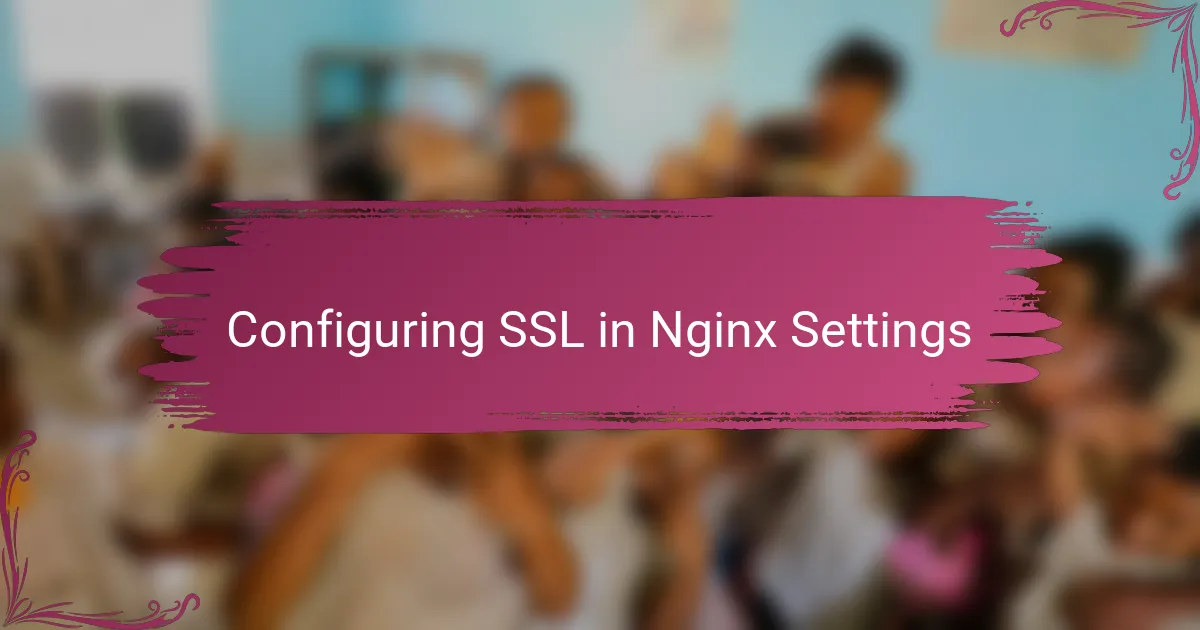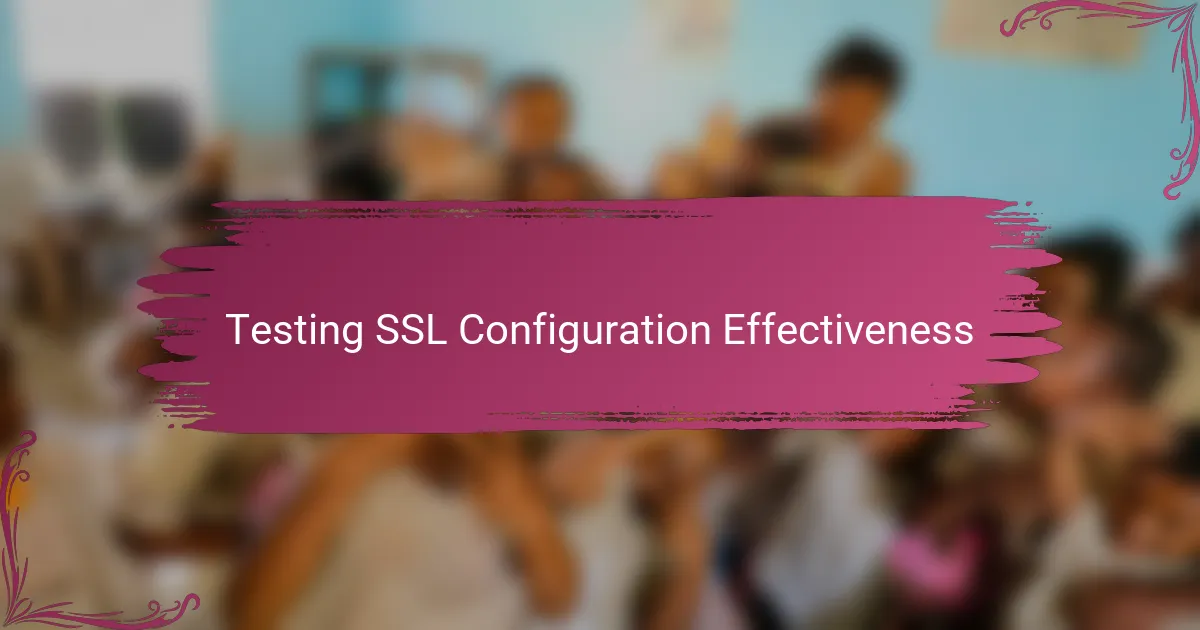Key takeaways
- SSL certificates are essential for verifying website identity and ensuring secure communication, thereby enhancing user trust and credibility.
- Nginx offers flexibility and efficiency, making it easy to configure SSL through straightforward directive management within server blocks.
- Thoroughly testing SSL configurations, using tools like SSL Labs and running OpenSSL commands, is crucial for ensuring security and compatibility across different browsers and devices.
- Implementing best practices, such as disabling outdated protocols and enabling strong cipher suites, significantly boosts Nginx SSL security.

Understanding SSL Certificates Overview
When I first encountered SSL certificates, they seemed like a mysterious barrier between me and secure communication. But understanding them is simpler than it appears: they essentially act as digital passports that verify a website’s identity and encrypt data exchanged with visitors. Have you ever wondered how your browser knows a site is trustworthy? That verification is thanks to SSL certificates.
In my early projects, I underestimated the importance of SSL until a client pointed out the warning messages visitors saw without it. That moment made me realize how SSL certificates are crucial not just for security but also for user trust and credibility. They build a shield against eavesdropping and data theft, especially on public networks.
Think of SSL certificates as a two-way handshake that reassures both the server and the client. It’s a process that involves cryptographic keys, but at its heart, it’s about creating a secure, private connection in a world that’s increasingly vulnerable to attacks. Once I grasped this concept, managing those certificates on Nginx felt much more approachable and purposeful.

Introduction to Nginx Web Server
Nginx first caught my attention because of its reputation for speed and efficiency. When I set it up the first time, I was impressed by how lightweight it felt compared to other servers I had tried. Have you ever noticed how some software just seems to run smoothly without hogging resources? That’s Nginx in action.
What really drew me in was its flexibility. It’s not just a web server; it can handle load balancing, reverse proxying, and much more. Early on, I appreciated that Nginx’s configuration files were straightforward yet powerful, making it easier for me to tailor setups to different needs without endless complexity.
Of course, mastering Nginx took some trial and error. But each time I tweaked a setting or learned a new directive, I felt more in control of my web environments. This confidence eventually made securing my sites with SSL certificates feel like a natural next step rather than a daunting task.

Preparing SSL Certificates for Nginx
Before diving into configuring SSL on Nginx, I always make sure to gather all the necessary certificate files. Typically, this means having the primary certificate, the private key, and sometimes a chain or bundle file from the Certificate Authority. Missing any of these felt like trying to assemble a puzzle without all the pieces—a frustrating experience I’d rather avoid.
Have you ever wondered how to organize these files for Nginx? From my experience, placing them in a dedicated directory with clear names saves a lot of headaches later. This small step felt like laying a solid foundation before building, and it gave me peace of mind that the configuration would be smooth.
One time, I tried using a certificate that wasn’t properly paired with its private key, and the server refused to start. That taught me the importance of verifying the match between the certificate and key beforehand, ensuring Nginx doesn’t run into errors. It’s a simple check that pays off by preventing frustrating troubleshooting down the line.

Configuring SSL in Nginx Settings
Configuring SSL in Nginx settings started to make more sense once I realized that the key lies in the server block where you specify the certificate and key file paths. Have you ever felt caught off guard by vague error messages after a config reload? I sure have, and most of the time it boiled down to a tiny typo or forgotten semicolon in this section.
I usually add the directives sslcertificate and sslcertificate_key right inside the server block, pointing them to the exact locations of my cert and key files. Setting the listen directive to 443 with ssl enabled is another must—without it, Nginx simply won’t serve HTTPS traffic, and that took me a minute to grasp early on.
One trick I picked up is to test the configuration with nginx -t before restarting the server—it saved me countless times from applying faulty settings. It’s a small step but it gave me confidence that everything was properly wired before going live, which eased my nerves especially on my first SSL-enabled site.

Testing SSL Configuration Effectiveness
Testing your SSL configuration is something I never skip, because no matter how confident I feel after setting up, there’s always that little nagging question: “Is this really secure?” Using tools like SSL Labs’ SSL Test became my go-to starting point—it gives a detailed report on everything from protocol support to certificate validity. I remember the relief I felt the first time my server scored an A+; it was proof that my careful steps truly paid off.
Another thing I’ve learned is that running OpenSSL commands on the server itself, like checking the handshake process or certificate details, can catch subtle issues before they affect visitors. These quick local tests gave me peace of mind, especially after tweaking settings like enabling HTTP/2 or adding HSTS headers. Do you know that moment when you see the green padlock in your browser? That’s the small victory that confirms your SSL setup is rock solid.
Of course, testing shouldn’t stop at automated tools. I found it incredibly helpful to manually access the site from different browsers and devices. Sometimes, obscure compatibility quirks pop up, and spotting them early saved me from embarrassing customer complaints. So, when was the last time you gave your SSL setup a thorough check? Trust me, it’s worth the extra minutes invested.

Troubleshooting Common SSL Issues
One recurring issue I ran into was the dreaded “SSL handshake failure.” At first, it felt like facing a brick wall because the error messages were so vague. After some digging, I realized it often boiled down to mismatched protocols or ciphers between the client and server—a subtle mismatch that can easily slip past unnoticed. Have you checked whether your SSL protocols are aligned in your Nginx config? It’s a small detail, but it saved me hours once I caught it.
Another classic that gave me headaches was the “certificate not trusted” warning in browsers. I once forgot to include the intermediate certificate bundle, and it felt like my site was treated as suspicious despite having a valid cert. Including the complete chain file in the configuration was a game-changer. I now always double-check the CA bundle path because skipping it means browsers might reject the trust chain, leaving visitors worried.
Then there’s the simple but often overlooked file permission problem. Early on, I faced an obscure “permission denied” error when Nginx couldn’t read the private key file. It took me a while to realize that the certificate and key files need the right ownership and permissions to be accessible by the Nginx user. Would you believe such a tiny oversight could halt the entire SSL setup? This taught me that attention to file permissions is just as crucial as the configuration itself.

Best Practices for Nginx SSL Security
Securing SSL on Nginx isn’t just about flipping a switch; it requires thoughtful attention to detail. One best practice I swear by is disabling outdated protocols like SSLv3 and TLS 1.0 right from the start. Have you ever wondered why your security scanners keep nagging about “weak protocols”? Turning these off not only boosts security but also ensures you’re not leaving obvious doors open for attackers.
Another thing I learned the hard way involves cipher suites. Picking the right ciphers felt overwhelming initially, but settling on strong, modern options like ECDHE and AES-GCM has made a world of difference. I always prioritize enabling Perfect Forward Secrecy—because to me, it’s about protecting past sessions even if the keys get compromised later. Do you realize how many servers overlook this and leave their data vulnerable?
Lastly, don’t underestimate the power of HTTP security headers like HSTS. When I first implemented strict transport security, I noticed users rarely encountered warning messages anymore, which boosted my confidence in the setup. Setting a long max-age and enabling preload might seem intimidating, but from experience, it’s a vital step that firmly signals browsers to always connect securely. Have you tried it yet? It’s a small tweak with big peace-of-mind benefits.